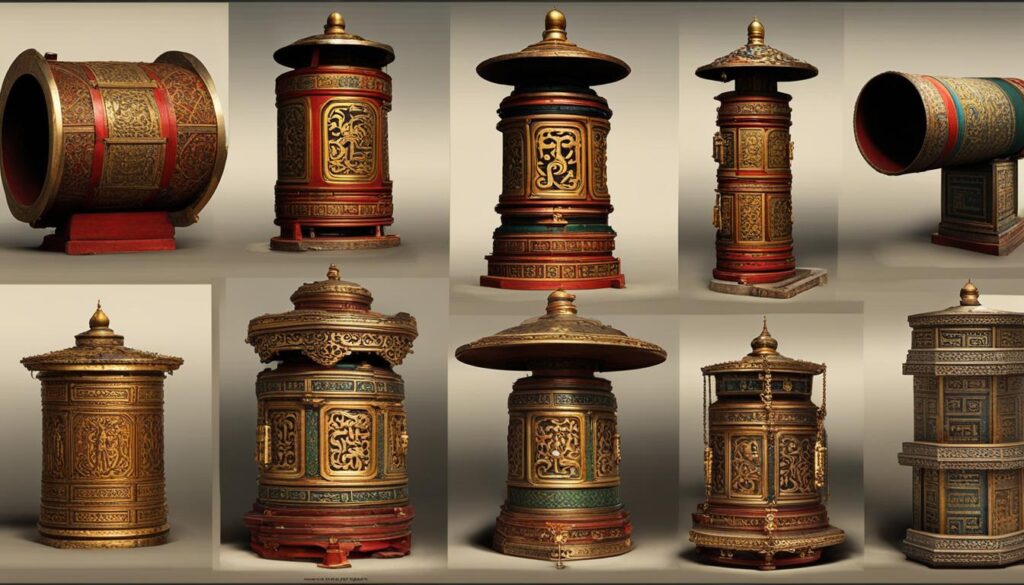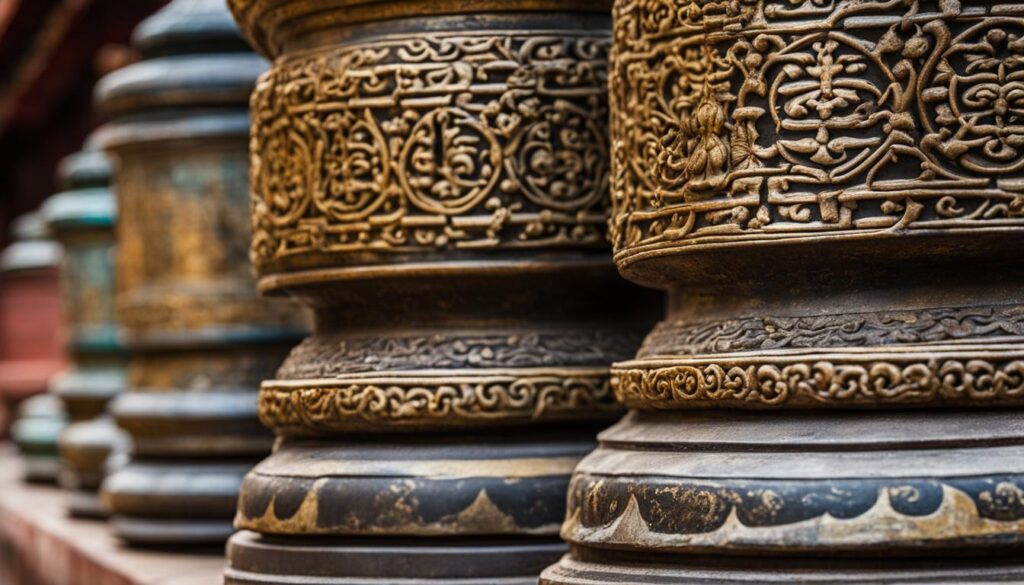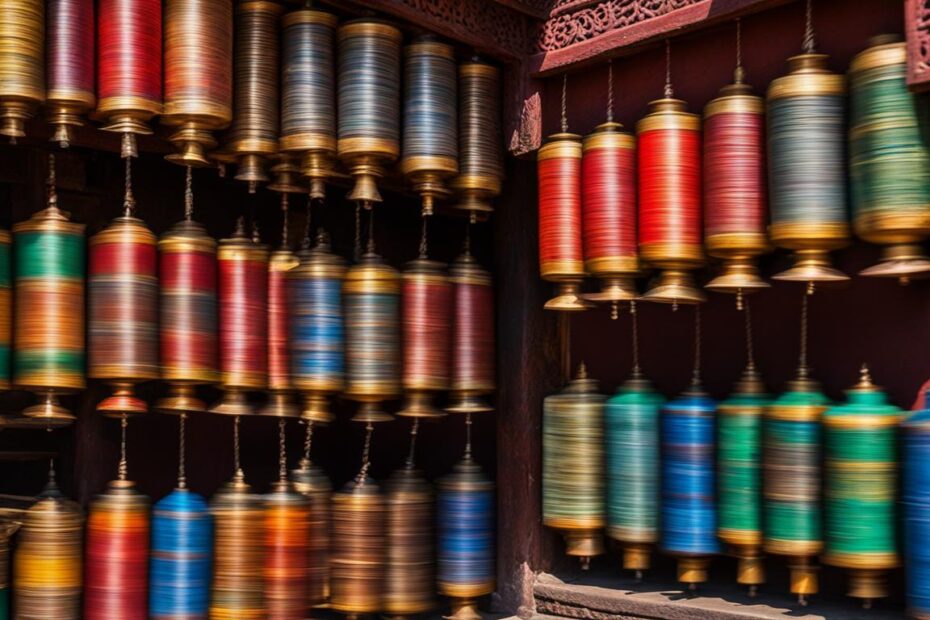The prayer wheels culture is a captivating aspect of Tibetan Buddhist tradition. These cylindrical wheels, inscribed with powerful mantras, hold deep spiritual significance and play a vital role in the lives of practitioners. Let’s dive into the fascinating world of prayer wheels and uncover the profound meaning behind this ancient practice.
The Spiritual Significance of Prayer Wheels
Prayer wheels hold immense spiritual significance in Tibetan Buddhism. By spinning the prayer wheel and reciting mantras, practitioners cultivate spiritual growth, mindfulness, and a stronger connection with the divine. The continuous rotation of the wheel represents the continuous flow of positive energy and blessings into the world. Prayer wheels are considered a form of meditation and offer a way to align oneself with higher vibrations and invite divine grace into one’s life.
Using a prayer wheel involves spinning it in a clockwise direction while reciting mantras. This spinning action releases positive energy and blessings into the universe. Mantra recitation intensifies the spiritual experience and helps calm the mind and cultivate mindfulness. Prayer wheels can be incorporated into meditation techniques to enhance the effectiveness of both practices. Practicing mindfulness while spinning the wheel allows individuals to fully engage with the present moment and strengthen their spiritual connection.
The spiritual significance of prayer wheels goes beyond personal growth and mindfulness. It extends to the belief in the interconnectedness of all beings. When a prayer wheel is spun, the positive energy and blessings emanating from it are believed to benefit not only the practitioner but also all sentient beings. This collective aspect reinforces the notion of compassion and the responsibility to contribute positively to the world.
Table: Comparative Analysis of Prayer Wheel Practices
| Aspect | Tibetan Buddhism | Nepal | Bhutan | China |
|---|---|---|---|---|
| Significance | Integral part of Tibetan Buddhist tradition | Common in monasteries, temples, and mountain trails | Used in religious ceremonies and festivals | Chanting mantras and invoking blessings |
| Spiritual Growth | Cultivate spiritual growth and mindfulness | Enhance spiritual connection and mindfulness | Promote spiritual well-being and resilience | Align with higher vibrations and invite divine grace |
| Interconnectedness | Symbolizes the interconnectedness of all beings | Emphasizes compassion and empathy towards others | Encourages self-compassion and alignment with values | Supports connection with the divine and well-being |
Source: Own research
The spiritual significance of prayer wheels transcends cultural boundaries. While deeply rooted in Tibetan Buddhism, prayer wheels have spread to other cultures, each with their own variations and interpretations. In Nepal, prayer wheels known as “mani wheels” are commonly found in monasteries, temples, and mountain trails. In Bhutan, prayer wheels are an integral part of religious ceremonies and festivals. China has its own version called the “chanting wheel,” used for chanting mantras and invoking blessings. These variations highlight the universality of prayer wheels as a tool for divine connection and spiritual well-being.
Benefits of Using Prayer Wheels
Engaging in prayer wheel practices offers numerous benefits for spiritual wellness and personal growth. By infusing daily life with blessings and positive energy, individuals experience increased positivity and cultivate compassion and empathy towards others. Prayer wheels also support self-compassion and resilience, helping individuals overcome challenges and align their actions with their values and faith. Using prayer wheels as part of a spiritual practice enhances overall well-being and promotes a deeper sense of inner peace.
Table: Benefits of Using Prayer Wheels
| Benefits | Description |
|---|---|
| Positive Energy | The spinning motion of the prayer wheel releases positive energy into the universe, promoting a sense of positivity and well-being. |
| Compassion and Empathy | Engaging with the prayer wheel cultivates compassion and empathy, allowing individuals to develop a deeper understanding and connection with others. |
| Self-Compassion | Prayer wheels serve as a reminder to be kind and compassionate towards oneself, fostering self-compassion and self-care. |
| Resilience | The practice of using prayer wheels helps individuals develop resilience, enabling them to overcome challenges and bounce back from adversity. |
| Alignment with Values | Prayer wheels provide a tangible tool for aligning one’s actions with their values and faith, promoting a sense of purpose and meaning in life. |
| Inner Peace | Regular use of prayer wheels contributes to a deeper sense of inner peace and tranquility, allowing individuals to find solace and clarity in their spiritual journey. |
By incorporating prayer wheel practices into daily life, individuals can experience the profound benefits of spiritual wellness, compassion, resilience, and inner peace. The continuous rotation of the prayer wheel serves as a reminder of our interconnectedness and the power of positive energy in transforming our lives and the world around us. Whether used as a tool for meditation or as a visual symbol of devotion, prayer wheels offer a pathway to spiritual growth and a deeper connection with the divine.
Methods of Using a Prayer Wheel
Using a prayer wheel involves a simple yet powerful process that combines spinning and mantra recitation to cultivate mindfulness and spiritual connection. Here are the steps to effectively use a prayer wheel:
- Hold the prayer wheel: Begin by grasping the prayer wheel firmly in your hand, ensuring a comfortable grip.
- Start spinning: Rotate the prayer wheel in a clockwise direction, using your wrist or fingers. The spinning motion should be smooth and continuous.
- Recite mantras: While spinning the prayer wheel, recite the chosen mantra silently or verbally. The most commonly used mantra is “Om Mani Padme Hum,” which is believed to invoke compassion and enlightenment.
- Cultivate mindfulness: As you spin the wheel and recite mantras, focus your attention on the present moment and the intention behind your practice. Let go of distractions and immerse yourself in the rhythm of the spinning wheel and the sacred vibrations of the mantras.
By following these steps, you can engage in a meditative and transformative experience with your prayer wheel, enhancing your spiritual well-being and deepening your connection with the divine.
Benefits of Using a Prayer Wheel
Engaging in prayer wheel practices offers numerous benefits for spiritual wellness and personal growth. Here are some key advantages:
- Spiritual wellness: Spinning the prayer wheel and reciting mantras infuse daily life with blessings and positive energy, promoting a sense of spiritual well-being.
- Compassion and empathy: The practice of using a prayer wheel cultivates compassion and empathy towards oneself and others, fostering a deeper understanding of interconnectedness and promoting harmonious relationships.
- Resilience and inner strength: Prayer wheels support self-compassion and resilience, helping individuals overcome challenges and align their actions with their values and faith.
- Mindfulness: By incorporating mindfulness into the prayer wheel practice, individuals can enhance their ability to focus, cultivate a sense of presence, and deepen their spiritual connection.
These benefits make using a prayer wheel a powerful tool for personal growth, spiritual development, and overall well-being.
Embracing the Power of Prayer Wheels
Prayer wheels hold a profound significance in various cultures, offering a tangible means of connecting with the divine and cultivating inner peace. Through the methodical spinning and mantra recitation, individuals can embark on a spiritual journey filled with mindfulness and compassion. By incorporating prayer wheel practices into daily life, one can experience the transformative power of this ancient tradition and enrich their spiritual path.
Image source:
The History of Prayer Wheels
The origins of prayer wheels can be traced back to ancient India, where the practice of reciting mantras held great importance. As Buddhism spread to Tibet, prayer wheels became an integral part of the Tibetan Buddhist tradition, evolving and adapting to the unique cultural context. The concept of spinning a cylindrical wheel inscribed with mantras to accumulate merit and blessings captured the imagination and devotion of the Tibetan people.
Over time, prayer wheels gained cultural significance beyond their religious importance. They became symbols of Tibetan identity and spiritual devotion. As Tibetans faced political and social challenges, the prayer wheel became a powerful tool for expressing their faith and preserving their cultural heritage. Today, the prayer wheel is deeply intertwined with Tibetan culture, representing a rich history of resilience, spirituality, and the pursuit of enlightenment.
| Aspect | Details |
|---|---|
| Origins | Prayer wheels originated in ancient India and spread to Tibet |
| Cultural Significance | Beyond their religious importance, prayer wheels have become symbols of Tibetan identity and spiritual devotion |
| Tibetan Culture | The prayer wheel embodies the resilience, spirituality, and cultural heritage of the Tibetan people |
The history of prayer wheels is a testament to the enduring power of faith and the profound impact of religious practices on cultures. From their humble beginnings to their widespread adoption, prayer wheels have become an integral part of Tibetan Buddhism and a symbol of devotion and cultural identity. The history of prayer wheels reminds us of the deep spiritual roots that connect us all and the diverse ways in which people express their faith.

“The prayer wheel is not only a spiritual tool but also a cultural emblem that represents the rich history and traditions of Tibet.”
The Significance of Prayer Wheels in Different Cultures
Prayer wheels, with their deep spiritual roots in Tibetan Buddhism, have transcended boundaries and found their significance in various other cultures as well. Let’s explore how prayer wheels are embraced and revered in different parts of the world, each adding its own unique cultural variations to this timeless practice.
Prayer Wheels in Nepal
In Nepal, prayer wheels, known as “mani wheels,” are widely prevalent in monasteries, temples, and even along mountain trails. These ornate wheels, often adorned with intricate designs and mantras, serve as a visual reminder of the divine presence and are used as a means of invoking blessings and cultivating spiritual connection. The spinning of mani wheels is seen as a way to bring positive energy into the surroundings and purify negativity.
Prayer Wheels in Bhutan
In Bhutan, prayer wheels hold a significant place in religious ceremonies and festivals. These prayer wheels, crafted with artistic precision, are often made of precious metals and adorned with sacred symbols. During religious rituals, devotees spin the prayer wheels rhythmically, accompanied by chants and prayers, to invite divine blessings and protection. The act of spinning the prayer wheel is regarded as a sacred offering and a way to deepen one’s devotion.
Prayer Wheels in China
In China, prayer wheels are known as the “chanting wheel” and are deeply integrated into Buddhist practices. These prayer wheels are typically larger in size and are spun while chanting mantras, invoking the presence of the divine and seeking spiritual guidance. The Chinese variation of prayer wheels serves as a powerful tool for connecting with the divine and fostering a sense of peace and harmony.
The significance of prayer wheels in these diverse cultures underlines their universal appeal as a means of divine connection and spiritual well-being. Although each culture may have its own variations, the essence remains the same: spinning the prayer wheel to release positive energy, invoke blessings, and cultivate a deeper sense of inner peace and harmony. The beauty of prayer wheels lies in their ability to transcend boundaries and resonate with people from different backgrounds, offering a tangible symbol of our shared spiritual journey.
| Culture | Prayer Wheel Name | Significance |
|---|---|---|
| Nepal | Mani Wheels | Invoking blessings, purifying negativity |
| Bhutan | Prayer Wheels | Deepening devotion, seeking divine protection |
| China | Chanting Wheel | Connecting with the divine, fostering inner harmony |
Observation of Prayer Wheel Wear Pads
One fascinating aspect of prayer wheel practices is the observation of prayer wheel wear pads. These wear pads are used to separate the handle from the rotating bamboo tube in hand-held prayer wheels. Over time, the wear pads undergo wear and tear due to the constant friction and abrasion caused by spinning the prayer wheel. This wearing down of the wear pads holds special significance for elderly Tibetans who see it as an incentive for their prayer wheel practice and consider it a valuable aspect of their spiritual journey.
The worn-down wear pads have acquired new value and symbolism. These exhausted wear pads are repurposed by Tibetans and used as amulets or beads in malas, which are Buddhist prayer beads. This transformation of the wear pads into sacred objects further embodies the spiritual significance of prayer wheels and the devotion of the practitioners. Each worn-down wear pad becomes a tangible reminder of the individual’s dedication to their spiritual path and their connection with the divine.
The observation of prayer wheel wear pads demonstrates the deep reverence and commitment that prayer wheel practitioners have towards their spiritual practices. It showcases the profound impact that the spinning of the prayer wheel has on their lives and the importance they place on cultivating positive energy and blessings. The wear pads serve as physical evidence of their spiritual journey, reminding them of the continuous flow of positive energy and the interconnectedness of all beings.

The Significance of Wear Pads
The wear pads on prayer wheels not only represent the passage of time and dedication but also serve as a powerful symbol of resilience and endurance. Just as the wear pads withstand the friction of constant spinning, individuals can draw inspiration from them to overcome challenges and difficulties in their own lives. The worn-down wear pads remind practitioners of their inner strength and remind them to persevere in the face of adversity.
Furthermore, the wear pads also symbolize the impermanence of life and the transient nature of material possessions. As the wear pads gradually wear away, they remind practitioners of the transient nature of the physical world and the importance of focusing on spiritual growth and inner transformation. This realization encourages individuals to detach themselves from material attachments and deepen their spiritual connection with the divine.
| Significance of Wear Pads | |
|---|---|
| Incentive for practice | The wearing down of the wear pads serves as an incentive for practitioners to continue their prayer wheel practice and deepen their spiritual journey. |
| Symbol of devotion | The repurposing of worn-down wear pads into amulets and beads signifies the deep devotion and connection that practitioners have with their spiritual path. |
| Resilience and endurance | The wear pads symbolize resilience and inspire individuals to overcome challenges and difficulties in their own lives. |
| Impermanence and detachment | The wearing away of wear pads reminds practitioners of the impermanence of life and encourages them to detach from material possessions. |
Conclusion
The culture of prayer wheels is a fascinating aspect of Tibetan Buddhism and other cultures around the world. By incorporating prayer wheel practices into their spiritual journey, individuals can deepen their connection with the divine and experience personal transformation.
The significance of prayer wheels lies in their ability to promote mindfulness and compassion. Engaging in the spinning of the prayer wheel while reciting mantras allows practitioners to align themselves with positive energy and invite blessings into their lives.
Prayer wheels serve as visual reminders of the interconnectedness of all beings and symbolize the continuous flow of positive energy and blessings. They offer a tangible tool for spiritual growth and personal well-being.
Embracing the prayer wheel culture can lead to a more meaningful and fulfilling spiritual journey, one that encompasses the values of mindfulness, compassion, and interconnectedness.
FAQ
What is the spiritual significance of prayer wheels?
Prayer wheels hold immense spiritual significance in Tibetan Buddhism and are believed to release positive energy and blessings into the world, promoting spiritual growth and purifying negativity.
What are the benefits of using prayer wheels?
Engaging in prayer wheel practices can enhance spiritual wellness, cultivate compassion and resilience, and promote a deeper sense of inner peace.
How do you use a prayer wheel?
To use a prayer wheel, spin it in a clockwise direction while reciting mantras. This spinning action releases positive energy and blessings into the universe.
What is the history of prayer wheels?
Prayer wheels have a rich history rooted in Tibetan Buddhism and can be traced back to ancient India. Over time, prayer wheels have evolved and spread to other cultures, each embracing their own variations and interpretations of the tradition.
What is the significance of prayer wheels in different cultures?
Prayer wheels have gained significance in various cultures, such as Nepal, Bhutan, and China, where they are used in religious ceremonies and festivals to invoke blessings and promote spiritual well-being.
What is the observation of prayer wheel wear pads?
Prayer wheel wear pads undergo wear and tear over time, and elderly Tibetans see this as an incentive for their spiritual practice. The worn-down wear pads are valued and used as amulets or beads in malas, further embodying the spiritual significance of prayer wheels.








